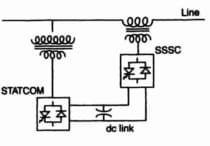Static voltage and phase angle regulators
1. In Voltage regulation, tap changers can, in general, be used to control _______flow in the line.
a. Active power
b. Reactive power
c. Apparent power
d. Resistance
2. PARs stands for__________.
a. Phase angle regulators
b. Power angle regulators
c. Plant active resistance
d. Programmable automatic resistor
3. PSTs stands for__________.
a. Phase shifting terminals
b. Phase shifting transformers
c. Power shifting terminals
d. Phase shifting transformers
4. Mechanical phase angle regulators or phase shifting transformers,
using on-load tap changers with quadrature voltage injection, were
introduced in the year__________.
a. 1924
b. 1926
c. 1928
d. 1930
5. The role of modern voltage phase angle regulators with fast electronic
control can also be extended to handle dynamic system events, such
as______________ and the corresponding voltage dips.
a. Transient stability improvement
b. Power oscillation damping
c. The minimization of post-disturbance overloads
d. All the above
6. The basic concept of _________ and phase angle regulation is the
addition of an appropriate in-phase or a quadrature component to the
prevailing terminal voltage in order to change it magnitude or angle to
the value specified.
a. Voltage
b. Current
c. Power
d. None of these
7. The basic concept of voltage and __________is the addition of an
appropriate in-phase or a quadrature component to the prevailing terminal
voltage in order to change it magnitude or angle to the value
specified.
a. Phase angle regulation
b. Phase angle rectification
c. Power angle regulation
d. Power angle rectification
8. As compared to reactive compensators, voltage and phase angle
regulators bring a new element to the control of dynamic events, the
capability to exchange__________.
a. Reactive power
b. Real power
c. Apparent power
d. None of these
9. The on-load tap changing voltage and angle regulators, lack the
ability of a reactive compensator to supply or absorb _________and thus
this burden is left to the power system to handle.
a. Real power
b. Reactive power
c. Apparent power
d. None of these
10. For small angular adjustments, the resultant angular change is
approximately_________ to the injected voltage, while the voltage
magnitude remains almost constant.
a. Inverse
b. Double
c. Proportional
d. Triple
11. For large angular adjustments, the magnitude of the system voltage
will appreciably __________.
a. Increase
b. Decrease
c. Both a & b
d. None of these
12. QBT stands for__________.
a. Quadrature balancing terminals
b. Quadrature booster terminals
c. Quadrature balancing transformer
d. Quadrature booster transformer
13. When power between two buses is transmitted over parallel lines of
different electrical length or when two buses are inserted whose
prevailing angle difference is insufficient to establish the desired power
flow. In these cases, a _____________is frequently applied.
a. Phase angle regulator
b. Quadrature booster transformer
c. Phase shifting transformer
d. None of these
14. TCVRs stands for ________.
a. Thyristor controlled voltage regulators
b. Thyristor controlled voltage rectifiers
c. TRIAC controlled voltage regulators
d. TRIAC controlled voltage rectifiers
15. TCPARs stands for________.
a. Thyristor controlled phase angle regulators
b. Thyristor controlled phase angle rectifiers
c. TRIAC controlled phase angle regulators
d. TRIAC controlled phase angle rectifiers
- MCQs on FACTS Page 1
- MCQs on FACTS Page 2
- MCQs on FACTS Page 3
- MCQs on FACTS Page 4
- MCQs on FACTS Page 5
- MCQs on FACTS Page 6
- MCQs on FACTS Page 7





0 Comments
If you have any doubt, feel free to ask.